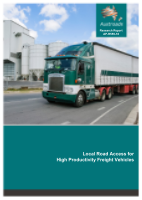Freight

- Publication no: AP-R559-18
- ISBN: 978-1-925671-27-8
- Published: 28 February 2018
- PDF (free) Download
This report examines the status of Australia's municipal Performance Based Standards (PBS) networks and the challenges of providing access to High Productivity Freight Vehicles (HPFV) on local roads.
The many challenges local road managers face when assessing roads for HPFV access are impeding Australia's progression towards safer and more efficient road freight transport.
A comprehensive outline of the contemporary barriers to local road access was compiled following an intensive consultation process including face-to-face interviews with more than 40 professionals from state road authorities, local government associations, local councils, transport industry associations, transport companies and other government agencies, and an online stakeholder survey.
Real-life case studies were compiled to demonstrate how some road managers have overcome concerns about swept path width, intersection clearance time, route compliance, increased infrastructure consumption, bridge loading and stakeholder acceptance to ultimately provide access where it was warranted.
Ten recommendations for further investigation are presented, focusing on education, funding needs, legislative change, appeals processes, cost recovery frameworks and route assessment guidelines and tools.
- Summary
- 1. Introduction
- 2. Status of Municipal PBS Networks
- 2.1. National overview
- 2.1.1. Queensland
- 2.1.2. Victoria
- 2.1.3. New South Wales
- 2.1.4. Tasmania
- 2.1.5. Northern Territory
- 2.1.6. Western Australia and South Australia
- 2.1.7. Australian Capital Territory
- 2.2. Demonstration of how positions can differ between road managers
- 2.2.1. Shire of Yarriambiack
- 2.2.2. Shire of Buloke
- 2.2.3. Shire of Gannawarra
- 2.2.4. Shire of Loddon
- 2.2.5. Shire of Campaspe
- 2.2.6. Rural City of Mildura
- 3. Stakeholder Consultation
- 4. Online Survey
- 4.1. Design
- 4.2. Data collection
- 4.3. Analysis
- 4.3.1. Local government respondents
- 4.3.2. Transport industry respondents
- 5. Barriers to Local Road Access
- 5.1. Misunderstanding the finite freight task
- 5.2. Misunderstanding the PBS Scheme
- 5.2.1. Perceived risks to safety, infrastructure or amenity
- 5.2.2. Mistaking PBS vehicles for HML/OSOM vehicles
- 5.2.3. Expecting swept path width to be too great
- 5.2.4. Misunderstanding of the relationship between PBS networks and existing networks
- 5.2.5. Distinguishing the difference between Class A and Class B networks
- 5.2.6. Axle group loads are the same
- 5.2.7. Difficulty interpreting a PBS Vehicle Approval
- 5.2.8. Lack of support from the National Heavy Vehicle Regulator (NHVR)
- 5.2.9. Staff changes and loss of corporate knowledge
- 5.3. Fear of unintended consequences or of personal liability
- 5.3.1. Opening the floodgates
- 5.3.2. Increased responsibility on local road managers
- 5.3.3. Outsourcing engineering assessments
- 5.3.4. Queensland-specific liability issues
- 5.4. Insufficient or unknown infrastructure capacity
- 5.4.1. Road geometry
- 5.4.2. Structures (bridges and culverts)
- 5.4.3. Pavements
- 5.5. Shortcomings of the Heavy Vehicle National Law (HVNL)
- 5.5.1. Road manager consent increases burden on municipalities
- 5.5.2. In-Principle Access Support has no legal status
- 5.5.3. No penalty for failing to resolve access within statutory timeframe
- 5.5.4. Acceptable reasons for access refusal are too broad
- 5.5.5. Appeals process does not include an independent review body
- 5.5.6. Existing access arrangements in New South Wales are no longer available
- 5.5.7. Permit pre-approvals being favoured over National Notices
- 5.6. Shortcomings of NHVR online tools
- 5.6.1. Journey Planner and Route Planner do not route heavy vehicles properly
- 5.6.2. NHVR Portal
- 5.7. Non-existent or inequitable cost recovery solutions
- 5.7.1. Infrastructure upgrades
- 5.7.2. Infrastructure capacity assessments
- 5.8. Lack of resources and tools
- 5.8.1. Route assessment guidelines
- 5.8.2. Restricted Access Vehicle Route Assessment Tool (RAVRAT)
- 5.8.3. Human resources
- 5.9. Perception of negative impact on amenity
- 5.10. Lack of economic incentive for the community
- 6. Case Studies
- 6.1. Case study #1 – Swept path template versus actual performance
- 6.2. Case study #2 – Swept path of Level 2B vehicle on B-double route
- 6.3. Case study #3 – Clearance time through unsignalised intersection
- 6.4. Case study #4 – Route compliance for a quad axle semi-trailer
- 6.5. Case study #5 – Road user charging
- 6.6. Case study #6 – Route assessment for variable PBS combination
- 6.7. Case study #7 – Explaining the benefits in meaningful terms
- 7. Recommendations
- 7.1. Recommendation #1 – Facilitate better knowledge and understanding of the PBS Scheme by road managers
- 7.2. Recommendation #2 – Outsource road asset audit & assessment
- 7.3. Recommendation #3 – Funding for structural upgrades/replacements
- 7.4. Recommendation #4 – Improve the governance of, and confidence in, in-principle access decision-making
- 7.5. Recommendation #5 – Incentivise on-time access approval
- 7.6. Recommendation #6 – Strengthen Section 156(3) of the HVNL
- 7.7. Recommendation #7 – Implement independent appeals process
- 7.8. Recommendation #8 – Implement better journey planning
- 7.9. Recommendation #9 – Implement cost recovery options
- 7.10. Recommendation #10 – Update route assessment tools
- References
- Appendix A Online Survey Questions
- Appendix B PBS Benefits Flyer (MRWA)
